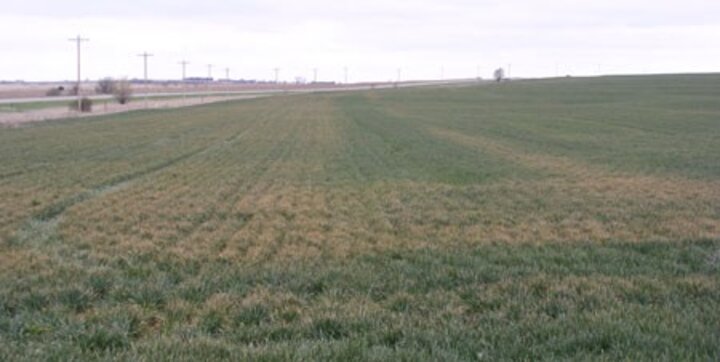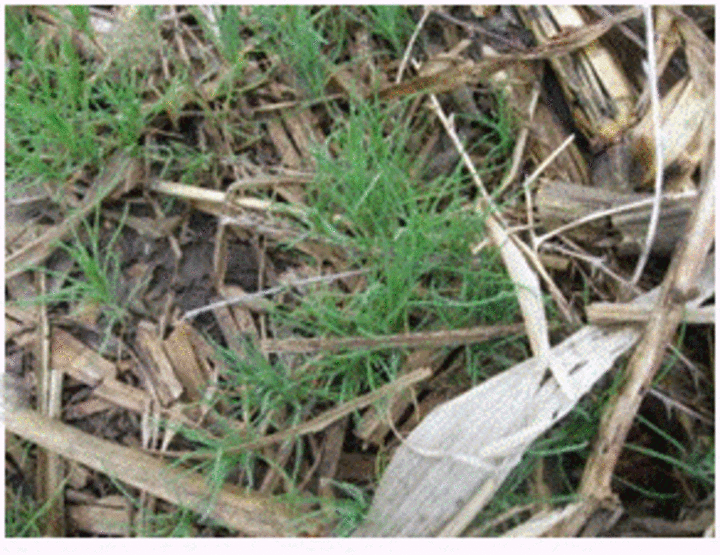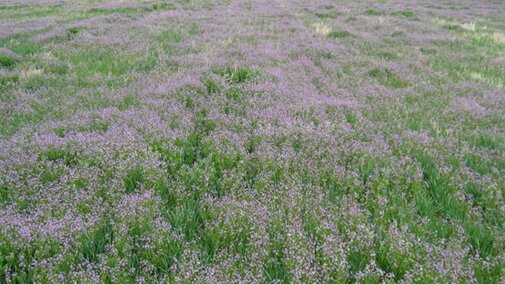Many winter wheat fields were seeded late last fall because of rainfall at normal planting time. The late seeding resulted in stands that are not as competitive with weeds and younger plants that can be more susceptible to herbicide injury. These conditions increase the importance of a good weed management plan. In addition, good weed control in winter wheat can increase success with the following crops.
Agility SG, Ally, Amber, Finesse, Huskie, Rave, and Starane NXT are among the products that have residual activity. Because of their residual activity, they also have crop rotation restrictions. The soil residual activity and foliar activity are why these products provide improved weed control. Check the crop rotation restriction before applying these and other products which may limit your future cropping system decisions.
Herbicides such as Affinity, MCPA, dicamba, and 2,4-D are short residual herbicides and do not provide much control of later emerging weeds.

Special Precautions with Stressed Wheat
When preparing your spring operations, don't mix your fertilizer and herbicide in one application (Figure 2). Adding fertilizer to the herbicide increases the possibility of injury to winter wheat. Fertilize as soon as field conditions permit in the spring. When applying liquid fertilizer, use a nozzle bar (Figure 3) or tip (Figure 4) that produces streams instead of sprays. This can help limit the potential for damage from fertilizer application in winter wheat stands stressed by lack of moisture.

Winter Annual Weed Control
Herbicides to control winter annual weeds need to be applied during mild weather when weeds are still in the rosette stage. Most herbicides perform poorly once weeds start to bolt and the winter wheat starts to develop a canopy.
Herbicide Options
Affinity BroadSpec herbicide is a premix of thifensulfuron (Harmony®) and tribenuron (Express®). Both are inhibitors of the ALS enzyme (Group 2). Affinity BroadSpec has equal parts of both chemicals, while Harmony Extra® has twice as much thifensulfuron as tribenuron. Like Harmony Extra and Express, Affinity BroadSpec will primarily be used for situations where a grower wants to leave crop rotation options open, for example, in irrigated production. Recrop intervals include: anytime to wheat and barley; 45 days to any crop other than sugar beets, winter rape, or canola. These latter, more sensitive crops can be planted after 60 days.
Apply Affinity BroadSpec to wheat from the two-leaf stage to before flag leaf emergence at the rate of 0.4 to 1.0 oz/ac. Add another labeled herbicide, such as 2,4-D. If using between 0.4 and 0.6 oz/ac, add NIS at a rate of 1 quart per 100 gallons of spray solution (0.25%) v/v.
MCPA and 2,4-D have different application guidelines. In general, MCPA is safer on wheat than 2,4-D, especially when applied prior to tillering. We recommend that 2,4-D not be applied to wheat until it is well-tillered in the spring. Applying 2,4-D prior to tillering hinders the tillering process, causes general stunting, and can result in significant yield loss.
The 2,4-D label provides for application to wheat from the full-tiller stage until prior to the boot stage of growth, but is probably safest between full-tiller and jointing stages of growth. Wheat will sometimes exhibit prostrate growth from 2,4-D applications applied in the jointing stage, but yields generally are not significantly affected if applied before the boot stage.
MCPA is relatively safe on young wheat and can be applied after the wheat is in the three-leaf stage (may vary by product label) until it reaches the boot stage. Consequently, MCPA would be preferred over 2,4-D if spraying before wheat is well-tillered. Neither MCPA or 2,4-D should be applied once the wheat is near or at the boot stage, as application could result in malformed heads, sterility, and significant yield loss.
Both 2,4-D and MCPA are available in ester or amine formulations. Ester formulations generally provide a little better weed control than amine formulations at the same application rates, but are more susceptible to vapor drift. Vapor drift is a problem when temperatures are above 80°F. Ester formulations generally are compatible with fertilizer carriers, while amine formulations often have physical compatibility problems when mixed with liquid fertilizer. Again, do not combine herbicides and fertilizer on stressed winter wheat.
Other herbicides used on wheat can be applied up to the time the flag leaf is visible, or sometimes later. Even though these herbicides can be applied later, weeds are much easier to control when small and before they provide competition to the winter wheat crop. Affinity BroadSpec, Affinity TankMix, Ally Extra SG, Harmony + 2,4-D or MCPA, and Harmony Extra must be applied before the flag leaf is visible. Huskie and WideMatch can be applied through the flag leaf stage. Herbicides that can be applied later in the spring — prior to the boot stage — include Ally + 2,4-D, Amber, Finesse, and Starane Ultra.
Dicamba can be applied to wheat between the two-leaf and jointing stages. Applying dicamba after wheat reaches the jointing stage causes severe prostrate growth of wheat and significant risk of yield loss. Dicamba is effective for control of kochia, Russian thistle, and wild buckwheat, but is not good for control of mustard species. Kochia, Russian thistle, and wild buckwheat are summer annual weeds that may emerge before or after wheat starts to joint, so timing of dicamba for control of these weeds can be difficult. Fortunately, dicamba provides some residual control of these weeds after application. Herbicides containing dicamba include Banvel, Clarity, Rave, Agility SG, and several generic dicamba products.
Other herbicides that must be applied prior to jointing include Agility SG, Beyond (on Clearfield varieties only), Olympus, Olympus Flex, Orion, PowerFlex, Pulsar, Rage D-Tech, and Rave.
Summer Annual Weed Control

Winter annual weeds are not the only concern where wheat stands are thin and wheat development is delayed. Early-germinating summer annual weeds such as kochia, Russian thistle, and wild buckwheat also may become a problem, especially at harvest. If not controlled in the winter wheat, these weeds will be cut off at harvest, making control almost impossible. Residual herbicides applied early in the season may control many of these weeds. If not applied then, apply postemergence treatments soon after weed emergence before the wheat gets too large to get good spray coverage and achieve the best results.
Summer Annual Herbicide Options
Dicamba is one of the most effective herbicides for kochia control, but as mentioned earlier, if the wheat is starting to joint, it shouldn't be applied. At that point, Starane Ultra or other herbicides containing fluroxypyr would be a safe option and could still provide good kochia control. Most other broadleaf herbicides in wheat can be sprayed from when wheat starts tillering until the early jointing stages of growth, but the label should always be consulted before application to confirm the recommended treatment stages.

